Ascot race to find Asian hornet nest
by Stephen Fleming, co-editor
Beekeepers have been following the news of Asian hornet nest searches in the UK for five years. But what really happens in the hunt for the nest of the invasive insect that threatens honey bees and other pollinators? The National Bee Unit gave BeeCraft exclusive access to observe the process at first hand and tell the full inside story for the first time.
A sight every beekeeper dreads
 It was about 11am on Wednesday 6 October during a varroa check on his bees in his apiary in Ascot, Berkshire, that Andy Mason noticed something that made his beekeeping antennae twitch with a mixture of excitement, elation and alarm. He had spotted a strange-looking insect that had alighted on the top of his National hive. Instinct took over and he swotted it. It looked like the dreaded Asian hornet (Vespa velutina), a creature he had read about and heard talks on at local BKA meetings during his 12 years as a beekeeper. He had even seen the hornets in southern France a few years ago, so he was fairly certain that this was it. Since 2016, the UK had destroyed ten nests of the invasive insect that threatened to wreak havoc with the pollination ecosystem of the country if it became established, so he knew he must take action.
It was about 11am on Wednesday 6 October during a varroa check on his bees in his apiary in Ascot, Berkshire, that Andy Mason noticed something that made his beekeeping antennae twitch with a mixture of excitement, elation and alarm. He had spotted a strange-looking insect that had alighted on the top of his National hive. Instinct took over and he swotted it. It looked like the dreaded Asian hornet (Vespa velutina), a creature he had read about and heard talks on at local BKA meetings during his 12 years as a beekeeper. He had even seen the hornets in southern France a few years ago, so he was fairly certain that this was it. Since 2016, the UK had destroyed ten nests of the invasive insect that threatened to wreak havoc with the pollination ecosystem of the country if it became established, so he knew he must take action.
As he watched, two more suspected Asian hornets arrived at the hive. “Oh hell!” he remembers thinking. “What’s going to happen now? They are going to eat my bees.” Quickly, he started videoing the new hornet arrivals and took some photos of the squashed one. Returning home, he looked online for BeeBase and downloaded the Asian Hornet Watch app, loaded up and sent off some still photos – and became even more concerned as he read more about the hornets and how quickly they can kill a colony.
Andy didn’t know what would happen next or how long it might take for anyone to respond. He feared that might be the last he would hear of his reporting. Despite the thousands of reports of misidentified Asian hornet sightings received by UK Centre for Ecology and Hydrology and the National Bee Unit (NBU) each year, it was quickly realised that this was the real thing and the NBU Asian hornet team sprang into action.
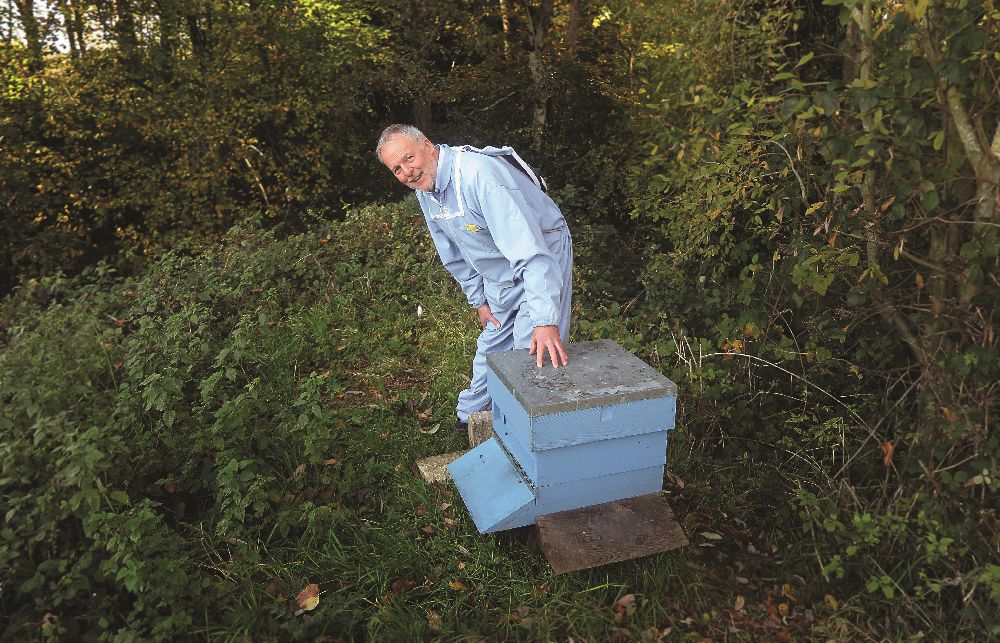 Mid-afternoon, Andy (pictured) was very pleasantly surprised and relieved to take a call from regional bee inspector Peter Davies who agreed that the insects photographed did indeed look like Asian hornets. In Asian hornet nest hunts, the local regional bee inspector takes on the role of incident commander with the task of co-ordinating the operation, a role that Peter has done several times before. Andy then sent additional video evidence to Peter, who immediately started arranging a visit by bee inspectors for the following morning (Thursday) to confirm the sighting. The NBU had been beginning to think that there would be no reports of sightings this year, but this evidence was convincing.
Mid-afternoon, Andy (pictured) was very pleasantly surprised and relieved to take a call from regional bee inspector Peter Davies who agreed that the insects photographed did indeed look like Asian hornets. In Asian hornet nest hunts, the local regional bee inspector takes on the role of incident commander with the task of co-ordinating the operation, a role that Peter has done several times before. Andy then sent additional video evidence to Peter, who immediately started arranging a visit by bee inspectors for the following morning (Thursday) to confirm the sighting. The NBU had been beginning to think that there would be no reports of sightings this year, but this evidence was convincing.
Dan Etheridge, regional bee inspector for South East England and now a veteran Asian hornet nest hunter having been involved in response teams at previous nest hunts, visited and confirmed the verdict on Thursday morning. Dan’s role in the nest hunt was as sector commander, responsible for the operations to track and trace to find the nest. He has taken inspiration from bee-lining techniques as demonstrated by Tom Seeley in the forests of Vermont, USA.
A team of six experienced NBU Asian hornet hunters was quickly assembled by Peter and sent to the town to set up about ten bait stations in the area, ready to track any hornets drawn to the bait back to their nest.
From previous searches for nests – ten successful finds over five years – the team expected that the nest would be very difficult to find. It would probably be high in a tree obscured by branches and leaves. The hornet may be a relatively new, if unwelcome, arrival to Europe from the Far East but it has proved to be very adaptable in its new environment and its nesting habits are as good as it gets to avoid discovery.
Finding the nest wasn’t the NBU team’s only task. Peter Davies contacted the BBKA and the Asian hornet team of the Slough, Windsor and Maidenhead BKA, inviting representatives along to explain what would be happening and to elicit their help in spreading the word among BKA members. Glynis Morse, president of the local BKA, emailed all its members, indicating that the dozen or so beekeepers within 5km of the sighting should be on extra-high alert. She asked them to be very vigilant and to watch for hawking or any other hornet activity around their hives. She and Niels Abildgaard, the local BKA chairman, returned on the Monday when the tracking was in full flight. “I was very impressed by the calm approach and the planning of the NBU,” she said. “These people knew exactly what they were doing. I was entirely confident in their ability and couldn’t fault them. I must say it was fascinating.” Having had previous experience of media encounters, Glynis batted away journalist enquiries and knew that, for confidentiality reasons, she must decline to answer questions from locals about the precise location. Since then, she has been keeping BKA members informed and on continuing alert for hornet activity.
Neighbours in two streets also had to be alerted not be alarmed by middle-aged men with binoculars looking above the roofs of the houses and requesting permission to enter gardens to set up bait stations. Leaflet drops and knocking on doors to give explanations were essential. Fortunately, no one objected – on the contrary, they were intrigued and eager to help where they could. The public relations aspect of the hunt was working well, though very few of the residents had ever heard of an Asian hornet. The local church opened its doors, its kitchen and its car park, and even members of local bridge-playing club meeting in the church hall were a little distracted.
Quiet Friday and foggy Saturday
Not much activity was discovered on Friday and the foggy Saturday was very frustrating because the hornets were unlikely to forage in those conditions. Finding the nest as soon as possible was a top priority because at this time of year it could be sending out viable queens (sexuals), perhaps 50 or even a lot more, some of which might survive winter and establish nests next season. Previous nest finds, often earlier in the season, had established that no viable queens had emerged from those nests, but this was a late-season find and the colony might be sufficiently advanced to be able to send out male and female sexuals.
A glimmer of light at dusk on Sunday
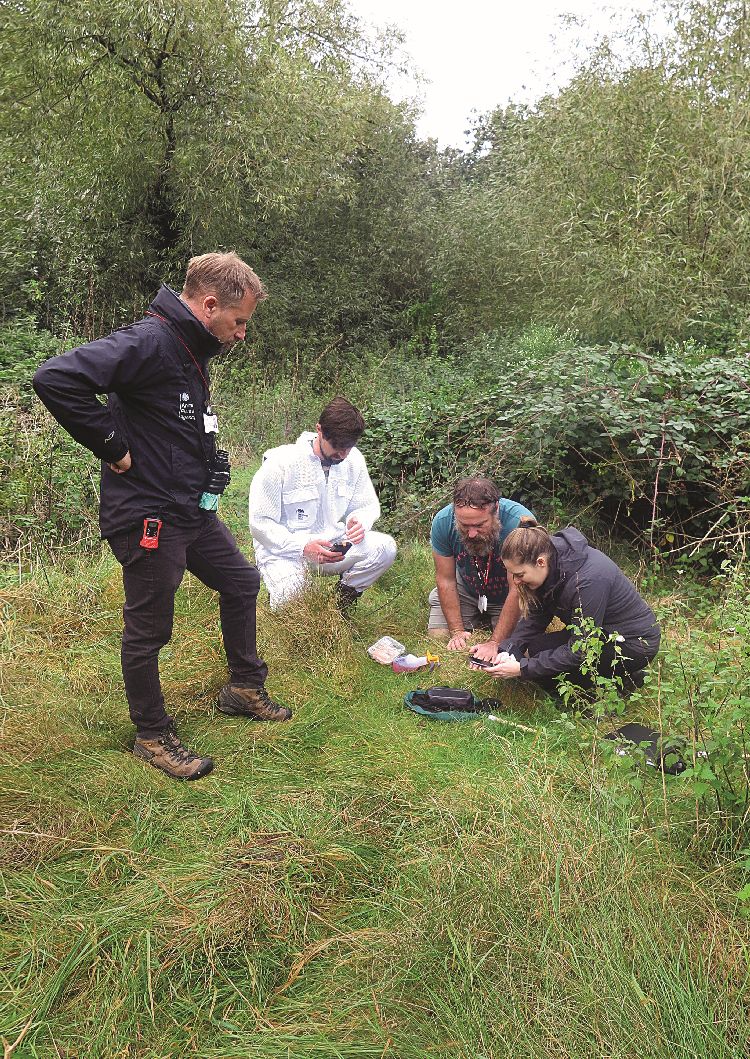 Hornet activity at the bait stations on Sunday picked up and, using track-and-trace mapping software, the NBU team could begin to establish some flight lines that should in theory lead to the nest. At the manned bait stations, any visiting hornets were caught in nets, where possible, marked and released (a task that only licensed individuals can do). Logging their departure times from the stations, the hope was that these same hornets would return for more bait and that the departure and return times would give a clue as to the distance to the nest. Combined with other sightings and triangulation of flight lines, the search area for the nest could be significantly reduced and, with luck, pinpointed.
Hornet activity at the bait stations on Sunday picked up and, using track-and-trace mapping software, the NBU team could begin to establish some flight lines that should in theory lead to the nest. At the manned bait stations, any visiting hornets were caught in nets, where possible, marked and released (a task that only licensed individuals can do). Logging their departure times from the stations, the hope was that these same hornets would return for more bait and that the departure and return times would give a clue as to the distance to the nest. Combined with other sightings and triangulation of flight lines, the search area for the nest could be significantly reduced and, with luck, pinpointed.
By the end of Sunday, Dan Etheridge had marked a dot on his map as his best guess of the nest location, but that wasn’t enough as it was in a very scraggy piece of dense woodland through which it was very difficult to move. Besides, it was part intuition based on previous experience and not incontrovertible evidence. Nonetheless, on Sunday – a day which he was supposed to have had off – he left with more optimism than on previous days. He had glimpsed a tiny tan-coloured fragment high in a tree that logged in his mind as a faint possibility of being a nest, but without further hornet activity, that glimpse offered little more than a hunch and might end as a wild goose chase distraction for a non-existent nest.
Monday dawns
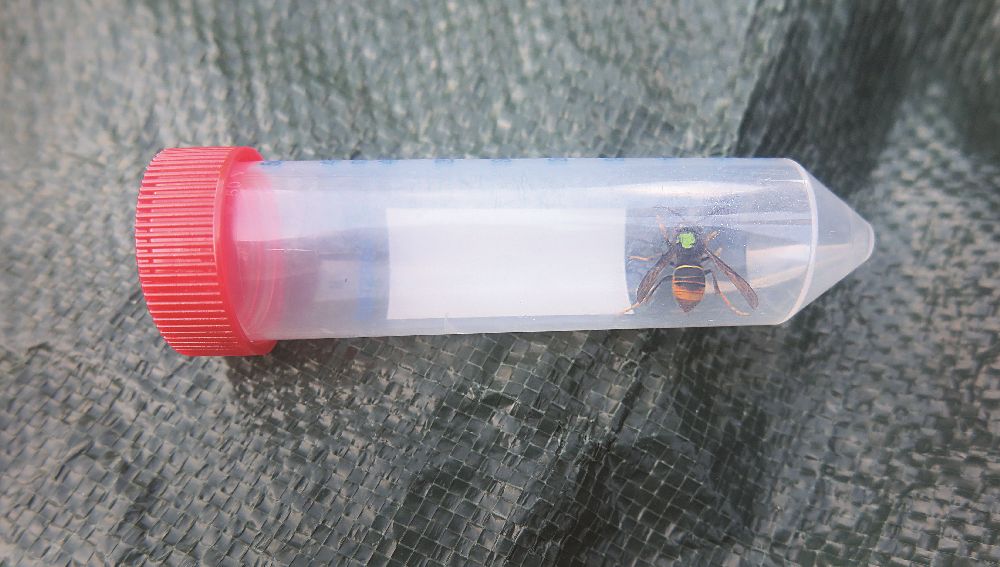 Monday morning, when I first arrived, started quietly. As the temperature increased, a few Asian hornets started to arrive at some bait stations. One hornet in particular – marked with a green dot by Mark Lynch, a seasonal bee inspector (SBI) in the Central England region – proved an excellent if unwitting informant. It arrived at a bait station set up on a garden shed that had flowering ivy creeping over its surface. This year, ivy has been a little late in the south of England, but it is a superb source of food for the Asian hornet. Not only does it provide carbohydrates from its nectar, but other pollinators – including honey bees, bumblebees, ivy bees – come to feed and inadvertently provide plentiful protein for the hornets to take back to feed the developing larvae in their nests.
Monday morning, when I first arrived, started quietly. As the temperature increased, a few Asian hornets started to arrive at some bait stations. One hornet in particular – marked with a green dot by Mark Lynch, a seasonal bee inspector (SBI) in the Central England region – proved an excellent if unwitting informant. It arrived at a bait station set up on a garden shed that had flowering ivy creeping over its surface. This year, ivy has been a little late in the south of England, but it is a superb source of food for the Asian hornet. Not only does it provide carbohydrates from its nectar, but other pollinators – including honey bees, bumblebees, ivy bees – come to feed and inadvertently provide plentiful protein for the hornets to take back to feed the developing larvae in their nests.
One of the problems in tracking the hornets was that some were grazing carbohydrates for their own sustenance and they weren’t that eager to return with protein to their nests. To add to the attraction of the bait stations, Suterra, a non-toxic commercial insect attractant, was sprayed on the foliage around them. It was fascinating to watch the different flight patterns of Asian hornets and European hornets, the former appearing very focussed compared to the more bumbling approach of the latter.
“It’s leaving now!” was heard over the walky-talky from the baitstation officer. Other observers positioned elsewhere stared into the clear blue skies to see if they could spot the speck of an insect returning home. “Is that it?” “Where?” “Oh, it’s gone now, but I think that could have been it, heading across between that chimney and the telegraph pole.” “Great, that’s towards the target area we identified yesterday.”
More calls of “it’s leaving” came through on the walky-talky but most could not be spotted high in the air, above the sloping ground where the hornet would quickly gain height because of the topography. But the search area was at last narrowing down to one triangular wood.
From a vantage point, Dan scanned the distant trees with his highpowered binoculars. Meanwhile, officers deep in the triangular wood were watching for hornets and scanning the tops of trees.
“There it is!” said Dan pointing high in the canopy shortly before mid-day. “Where?” I asked, “all I can see is branches and leaves.” Then I saw it – well, barely. Just a glimpse of tan among leaves and branches near the top of a tree. Its complete outline couldn’t be seen. To say that it was a subtle observation would be quite the understatement. I took my eyes off it for a second and took quite some time to spot it again.
Team members nearby descended into the wood, straining their necks and eyes looking high into the tree canopy to try to find the nest. Despite knowing that it was in about a five-metre radius, it still proved elusive to see from below. After a few minutes it was spotted. Success! The location turned out to be just a few metres from Dan’s Sunday evening pin-in-the-map guesstimate.
But the job wasn’t over. How to kill the occupants? How to retrieve the nest for analysis? And on whose land is it anyway? Background work had already etablished that the wood had several owners and access was gained.
Meanwhile the team of inspectors replaced the bait stations with kill-traps as they did not need to track the hornets anymore, and collected samples requested by Fera Science labs and the Natural History Museum.
Cease and desist!
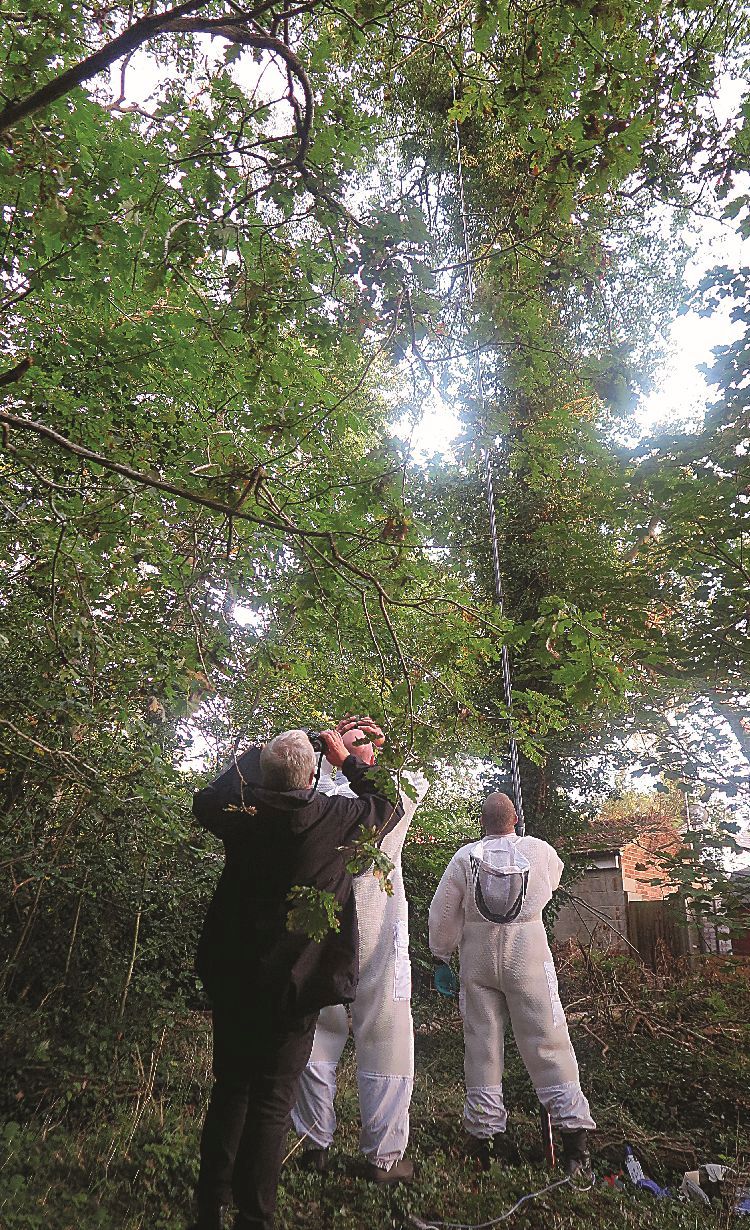 The Defra nest destructors (not their only job) were called in and were eager to get on with the job. As dusk fell on Monday and the hornets settled back in their nest, an extendable pole was launched 20 metres up into the canopy of the tree. A lance at the top held the chemical that would dispatch the hornets; a flexible plastic tube ran through the pole and an aerosol at the bottom, when released, would launch the pesticide through the lance at the top into the entrance of the nest. Because of changing regulations, this was the first time this particular chemical had been used on hornets, so only time – 12 hours to be precise – would tell how well it had worked.
The Defra nest destructors (not their only job) were called in and were eager to get on with the job. As dusk fell on Monday and the hornets settled back in their nest, an extendable pole was launched 20 metres up into the canopy of the tree. A lance at the top held the chemical that would dispatch the hornets; a flexible plastic tube ran through the pole and an aerosol at the bottom, when released, would launch the pesticide through the lance at the top into the entrance of the nest. Because of changing regulations, this was the first time this particular chemical had been used on hornets, so only time – 12 hours to be precise – would tell how well it had worked.
Tuesday denouement
Next morning, Tuesday, the NBU team, the nest destructors and a tree-surgeon agency turned up on site. Wisely, news of the find had not yet been released, so only essential personnel (plus me) were present on site. To have had spectators would have courted high risk. Police had been informed and only their signs quietly directed people away from a nearby footpath that was uncomfortably close to the nest. The traffic whizzed by, just a cricket strip away from the nest.
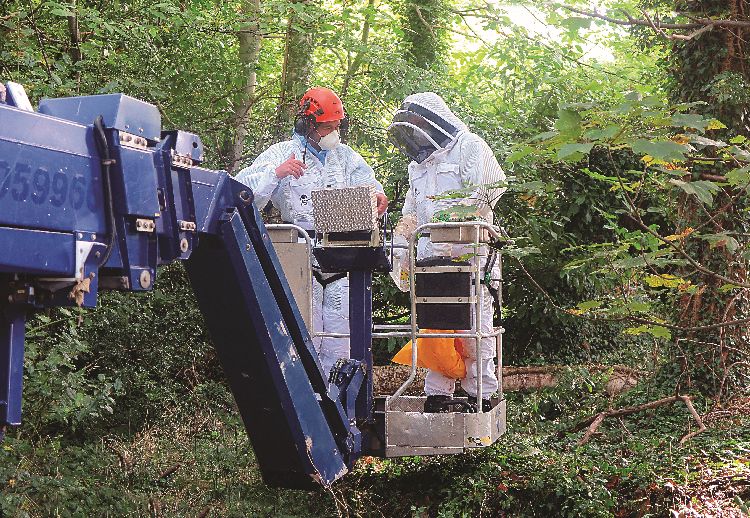 Luckily, the hornets had chosen a site not too deep into the woods that was accessible to a cherry picker once some undergrowth had been cleared. The relatively accessible location in a wood that was almost impenetrable in parts may not have been entirely due to luck – the hornets had chosen a spot where their nest gained some heat from the sun, so the edge of a wood might not just have been a lucky chance. There is so much we have yet to learn about this new invader.
Luckily, the hornets had chosen a site not too deep into the woods that was accessible to a cherry picker once some undergrowth had been cleared. The relatively accessible location in a wood that was almost impenetrable in parts may not have been entirely due to luck – the hornets had chosen a spot where their nest gained some heat from the sun, so the edge of a wood might not just have been a lucky chance. There is so much we have yet to learn about this new invader.
The first morning inspection of the nest showed that some hornets were still around the nest. Had the pesticide not worked sufficiently well? A dose of knock-down spray was delivered to kill any remaining hornets, this time up-close on a cherry picker by personnel in chemical- and hornet-proof suits. Everyone stood well back, prepared to retreat even further if the hornets had taken exception to such an intrusion.
The hornet activity soon stopped after that second dose. It’s possible that, even like honey bees and bumblebees, there are some ‘stop-outs’ each night, perhaps caught too far from home to return in the dark, and that it was those, unaffected by the previous night’s pesticide attack, that were returning to the nest and creating the illusion of a surviving colony.
The besuited operators came back down to be sure activity had stopped and the cherry picker location adjusted to enable easier access so that the nest could be lowered safely to the ground. Several lopped branches later, down came the nest in all its beauty. It was completely intact, so no one was able to see inside. It went straight into a protective container and whisked off to NBU/Fera labs in York, almost exactly 24 hours after it had first been seen.
The nest, about 35cm in diameter, was one of the biggest yet discovered in Britain. Seasoned observers thought it was similar in size to that of the first British nest discovered in Tetbury in 2017. The size was a concern. Despite the oddities of the 2021 season, the nest was well developed, and no one could yet know if sexuals had emerged from it.
Nonetheless, the team was visibly relieved and delighted to have accomplished its task so quickly despite the difficult conditions. The thrill of a successful chase was obvious. Bee inspectors had come in from other areas, some in their own time, to share the experience so that they would be better informed should the invader make an appearance in their area.
We now await the results over the winter to see if the genetics of the nest occupants can tell us if they came direct from France or a new migrant direct from the Far East. Analysis of the brood should indicate if the nest was deactivated in time to prevent the escape of next year’s potential queens.
Mopping up – crucial to the hunt
However, the job in Ascot was not yet complete. There was always the possibility that there could be more than one nest in the area and as yet there was no sign of the primary nest, likely close to the ground, from which the secondary nest was spawned. The lack of activity around the base of the tree suggested that the primary nest had been abandoned.
The local Asian hornet team, volunteers from the local BKA, had of course been aware of the exercise and two members had taken part in the search. Now, their contribution could be of huge significance by urging their members to be especially alert and to place and monitor Asian hornet traps. Meanwhile, the NBU team located about 40 traps in three roughly concentric circles (250m, 500m and 1km) around the discovered nest.
Although more hornets than usual were caught in traps in the days after the nest’s removal, it is not thought that there is another secondary nest in the area. The number of hornets found after the event is thought to be a result of the different chemical used because pesticides used in previous years are no longer permitted to be used in situations where this invader is found.
The primary nest in which the queen would have started the colony in spring has not been discovered but, because it would not have produced sexuals, the mystery of its location is not a concern.
Peter Davies outlined the wide range of contacts involved in the seven-day incident: “Finding the nest and thereby keeping the Asian hornets at bay is a team effort involving the observant beekeeper who first reported the sighting, NBU (inspectors, management, support and technical staff), the local Asian hornet team and local beekeepers, the Defra wildlife team, the tree specialists, local residents and businesses. During the outbreak I also liaised with the very experienced Jersey Asian hornet team members for help in understanding Asian hornet behaviours we had not witnessed previously.
“Following each incursion, the NBU team holds a thorough debriefing session to learn the lessons at each incident to ensure that ideas and improvements can be captured to improve the whole process. Already we have deployed them on another successful nest-finding mission in Portsmouth where, over the course of two days, we were alerted to an Asian hornet sighting and found and removed a nest in a tree.”
Preliminary findings
Initial analysis of the Ascot nest indicates that it was too young to be capable of producing gynes (insects destined to become queens). Genetic analysis in the laboratory will be performed to try to establish the origin of the colony.
In the weeks after the nest removal, further trapping provided no evidence of any other nest in the area. On 4 November, exactly four weeks after the Asian hornet team arrived in Ascot, the team felt that it was safe enough to remove its traps. Local beekeepers are asked to remain on the alert.
Photos; Peter Davies, Andy Mason, Stephen Fleming.
Stephen Fleming and BeeCraft thank NBU personnel for enabling virtually unimpeded access to the Ascot Asian hornet nest hunt. As beekeepers in the area found, it was a pleasure and an education working with such a dedicated team in their aim to prevent Vespa velutina from establishing itself in this country.
December 2021
Other articles this month included:
The joys of beekeeping – time away from bees need not be disappointing
A mouse-proof floor – building a year-round mouse-proof entrance
Plus - gardening for pollinators, how to make rose bath melts, Stefanka cake recipe, book reviews and lots more
Subscribe to BeeCraft Magazine
- £27.00* - Digital Subscription | 12 months
- £45.00* - UK Printed Subscription | 12 months
- £80.00 - UK Printed Subscription | 24 months
* UK residents over the age of 18 can subscribe to BeeCraft via Direct Debit and save up to £7.00 on your subscription. For more information on our Direct Debit scheme, please click here.
- £27.00 - Digital Subscription | 12 months
- £50.00 - Digital Subscription | 24 months
- £67.00 - RoI & European Printed Subscription | 12 months
- £27.00 - Digital Subscription | 12 months
- £50.00 - Digital Subscription | 24 months
- £90.00 - Worldwide Printed Subscription | 12 months



